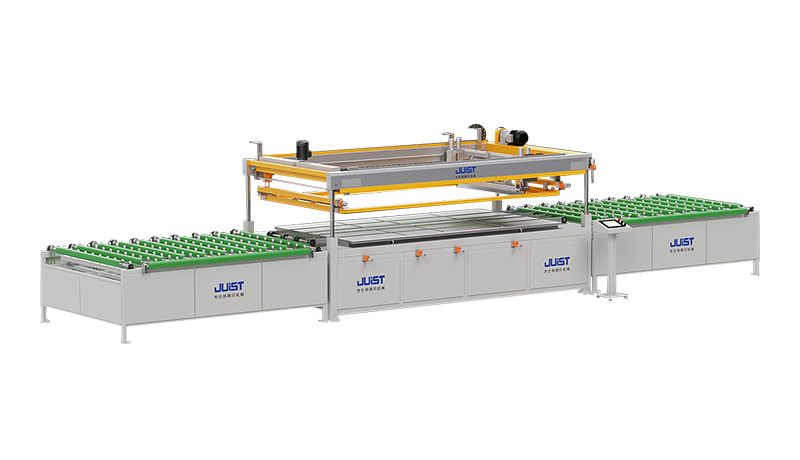+86-519-83387581
In modern manufacturing, glass is no longer merely a transparent material. It has been endowed with various colors, patterns, and functions, becoming a fusion of aesthetics and practicality. Whether it’s the cover glass of a mobile phone, a car windshield, or the control panel of home appliances, exquisite printing on glass plays a crucial role. However, traditional screen printing methods often require extensive manual operations, which are not only inefficient but also struggle to ensure printing precision and consistency—especially when multi-color printing is needed, where color registration becomes an arduous challenge. This approach can no longer meet the current market’s urgent demand for high precision, efficiency, and low costs. Against this backdrop, the fully automatic two-color glass screen printing machine emerged, revolutionizing traditional glass printing with its exceptional automation capabilities and precise printing technology.
Why Is a Fully Automatic Two-Color Glass Screen Printing Machine Needed?
In the past, multi-color printing on glass products typically involved multiple manual color registrations, with each step requiring manual loading, positioning, and unloading of glass. This process was time-consuming and labor-intensive, and human factors could easily lead to printing deviations and defective products. As market competition intensifies, enterprises urgently need to improve production efficiency and product quality to reduce costs and meet consumers’ increasingly strict requirements for product appearance.
Particularly in fields such as automotive glass, home appliance panels, and photovoltaic glass, the contradiction between mass production and high-precision printing has become increasingly prominent. The fully automatic two-color glass screen printing machine was developed to address these pain points. Through a complete automated system, it can complete glass loading, two-color printing, and unloading in one go, significantly shortening the production cycle, increasing productivity, and fundamentally ensuring printing stability and consistency.

Exploring the Working Principle of Fully Automatic Two-Color Screen Printing Machines
The core of a fully automatic two-color screen printing machine lies in its highly integrated automation system. The machine first uses an automatic loading and unloading device to adsorb the glass panel and accurately transport it to the printing station. Once the glass is in place, a high-precision positioning system—usually a robotic arm based on visual recognition technology—ensures the glass is in the exact printing position.
During two-color printing, the machine first prints the first color, then uses its internal conveying system to smoothly move the glass to the second printing station for the second color. The entire process requires no manual intervention, ensuring precise color registration between the two print runs. This continuous printing mode not only greatly increases printing speed but also avoids error accumulation caused by repeated positioning in traditional manual operations.
From Flat to Curved: Flexibly Tackling Different Printing Challenges
Glass is used in a variety of scenarios, from flat architectural glass to curved car rearview mirrors and mobile phone covers, with diverse shapes. This requires printing equipment to have high adaptability.
Fully automatic two-color screen printing machines excel at fine printing on flat glass, ensuring sharp pattern edges by precisely controlling squeegee pressure and printing speed. They can also easily handle curved glass printing through special fixture and print head designs. For curved printing, the equipment adjusts the printing angle and squeegee stroke to ensure ink adheres evenly to irregular surfaces while maintaining pattern integrity and color saturation. This flexible printing capability for different glass shapes allows fully automatic screen printing machines to be applied in a wider range of fields.
Smart Printing: Balancing High Precision and Efficiency
In modern manufacturing, smart technology is key to achieving high precision and efficiency. Fully automatic two-color screen printing machines are usually equipped with visual recognition and intelligent calibration systems. Before printing, high-resolution cameras scan the glass, identify its position and shape, compare it with the preset printing template, and automatically adjust the printing position to ensure each print is accurate.
If minor deviations occur during printing, the intelligent system can also make real-time compensations to prevent defective products. This intelligent, automated calibration function not only greatly improves printing precision but also reduces reliance on operators’ professional skills, thereby lowering labor costs. Through intelligent data collection and analysis, production managers can also monitor production status in real time, optimize production processes, and further improve overall efficiency.
Beyond Decoration: Application Scenarios of Fully Automatic Two-Color Screen Printing Machines
The applications of fully automatic two-color glass screen printing machines extend far beyond traditional decorative fields.
- In the home appliance industry, they are used to print control panels for refrigerators, washing machines, air conditioners, etc., enhancing product aesthetics and functionality.
- In the automotive industry, they print sunshade black edges, logos, and heating lines on car glass, ensuring driving safety and vehicle appearance.
- In construction, they print patterns on curtain wall glass to achieve both energy-saving and decorative effects.
Notably, in photovoltaic glass production, fully automatic two-color screen printing machines are used to print electrodes for solar panels—their high precision and efficiency are crucial for improving the performance of photovoltaic modules. Additionally, in medical devices and electronic equipment, the demand for fine glass printing is growing. With its excellent performance, the fully automatic two-color screen printing machine is becoming an indispensable core equipment in these industries.








